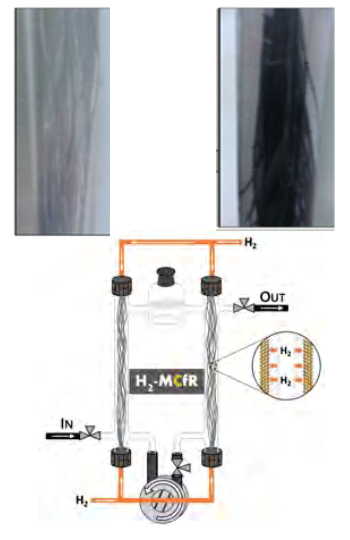Reduction of Oxidized and Halogenated Pollutants in Drinking Water Via a Nanoparticle Catalyst Supported on Hydrogen Permeable Hollow Fiber Membranes
Outcome/Accomplishment
Researchers with the Nanotechnology Enabled Water Treatment (NEWT) Nanotechnology Engineering Research Center (ERC) at Rice University have completed the design and testing of an indium-palladium (InPd) nanoparticle (NP) catalyst aging study in six different water chemistries representing tap water, regenerant solutions, and end-of-life landfill simulants. The work by National Science Foundation (NSF)-funded researchers demonstrates successful nitrate conversion to non-water-soluble forms, successfully accomplishing de-nitrification.
Impact/Benefits
With the prevalent use of fertilizers in agriculture, harmful nitrates increasingly pollute runoff water, negatively impacting the health and environments of nearby communities. While ion-exchange filters can be used to remove the resulting toxins, these require repeat flushing and tend to return more concentrated toxins back to the water supply. As carcinogens, nitrates are dangerous to pregnant women and children, particularly in the U.S. Corn Belt and California's Central Valley. NEWT's efforts aim to reduce nitrate to gaseous nitrogen (N2) using hydrogen delivered to NP catalysts mounted on gas-permeable membranes. The application directly treats groundwater and could prove beneficial for global drinking water supplies.
Explanation/Background
NEWT's work built upon a prior process model to control selectivity to nitrogen gas; the researchers used a novel bimetallic InPd catalyst to reduce NO3 to innocuous N2 gas using H2 gas-permeable 1 millimeter (mm)-diameter fibers. A "unified catalyst aging" procedure was applied to the InPd catalyst. The composition of the model solutions led to gradual changes in surface composition, morphology, or catalytic reactivity. The objective was to scale-up to a continuous-flow nitrate reduction reactor, evaluate its performance, and assess and minimize catalyst deactivation.
The team led by Paul Westerhoff achieved greater than 90% selectivity to N2 from nitrate using InPd catalysts on the H2-permeable fiber system. A corresponding rise in pH was observed and identified as a primary driver for ammonium ion formation. But because Pd is a significant cost driver, the team is investigating the use of more earth-abundant catalysts, such as nickel-copper alloys, as alternatives. By adding carbon dioxide (CO2) simultaneously with H2 a natural buffering capability is observed.
The reactor was converted from batch to continuous flow. The recirculating batch-scale reactor successfully accomplished de-nitrification with a high selectivity for N2. Four different methods were used to coat InPd on the H2-permeable hollow-fiber polymer membranes; the team concluded that the fourth method of in-situ InPd synthesis provides the best performance for nitrate reduction. It releases less than 1% of the catalyst over several operation cycles. This method is being used exclusively in experiments by the team moving forward.
The work resulted in two published papers and a presentation at the virtual American Institute of Chemical Engineers (AICHE) meeting by Juliana Levi. Two additional papers will follow.
Location
Houston, Texaswebsite
Start Year
Energy and Sustainability
Energy, Sustainability, and Infrastructure
Lead Institution
Core Partners
Fact Sheet
Outcome/Accomplishment
Researchers with the Nanotechnology Enabled Water Treatment (NEWT) Nanotechnology Engineering Research Center (ERC) at Rice University have completed the design and testing of an indium-palladium (InPd) nanoparticle (NP) catalyst aging study in six different water chemistries representing tap water, regenerant solutions, and end-of-life landfill simulants. The work by National Science Foundation (NSF)-funded researchers demonstrates successful nitrate conversion to non-water-soluble forms, successfully accomplishing de-nitrification.
Location
Houston, Texaswebsite
Start Year
Energy and Sustainability
Energy, Sustainability, and Infrastructure
Lead Institution
Core Partners
Fact Sheet
Impact/benefits
With the prevalent use of fertilizers in agriculture, harmful nitrates increasingly pollute runoff water, negatively impacting the health and environments of nearby communities. While ion-exchange filters can be used to remove the resulting toxins, these require repeat flushing and tend to return more concentrated toxins back to the water supply. As carcinogens, nitrates are dangerous to pregnant women and children, particularly in the U.S. Corn Belt and California's Central Valley. NEWT's efforts aim to reduce nitrate to gaseous nitrogen (N2) using hydrogen delivered to NP catalysts mounted on gas-permeable membranes. The application directly treats groundwater and could prove beneficial for global drinking water supplies.
Explanation/Background
NEWT's work built upon a prior process model to control selectivity to nitrogen gas; the researchers used a novel bimetallic InPd catalyst to reduce NO3 to innocuous N2 gas using H2 gas-permeable 1 millimeter (mm)-diameter fibers. A "unified catalyst aging" procedure was applied to the InPd catalyst. The composition of the model solutions led to gradual changes in surface composition, morphology, or catalytic reactivity. The objective was to scale-up to a continuous-flow nitrate reduction reactor, evaluate its performance, and assess and minimize catalyst deactivation.
The team led by Paul Westerhoff achieved greater than 90% selectivity to N2 from nitrate using InPd catalysts on the H2-permeable fiber system. A corresponding rise in pH was observed and identified as a primary driver for ammonium ion formation. But because Pd is a significant cost driver, the team is investigating the use of more earth-abundant catalysts, such as nickel-copper alloys, as alternatives. By adding carbon dioxide (CO2) simultaneously with H2 a natural buffering capability is observed.
The reactor was converted from batch to continuous flow. The recirculating batch-scale reactor successfully accomplished de-nitrification with a high selectivity for N2. Four different methods were used to coat InPd on the H2-permeable hollow-fiber polymer membranes; the team concluded that the fourth method of in-situ InPd synthesis provides the best performance for nitrate reduction. It releases less than 1% of the catalyst over several operation cycles. This method is being used exclusively in experiments by the team moving forward.
The work resulted in two published papers and a presentation at the virtual American Institute of Chemical Engineers (AICHE) meeting by Juliana Levi. Two additional papers will follow.

